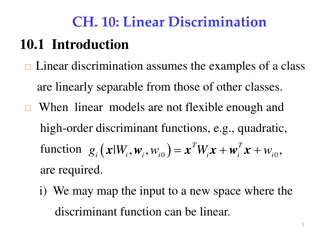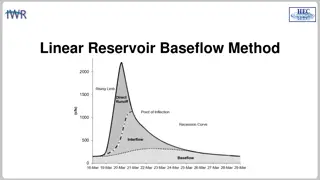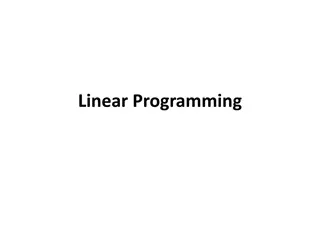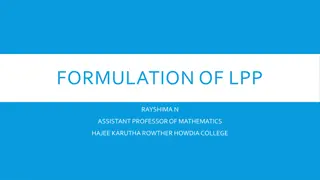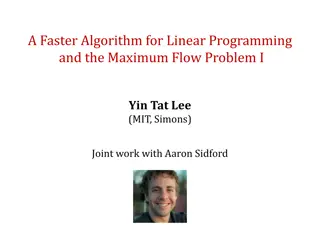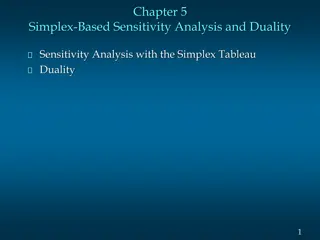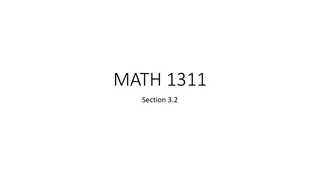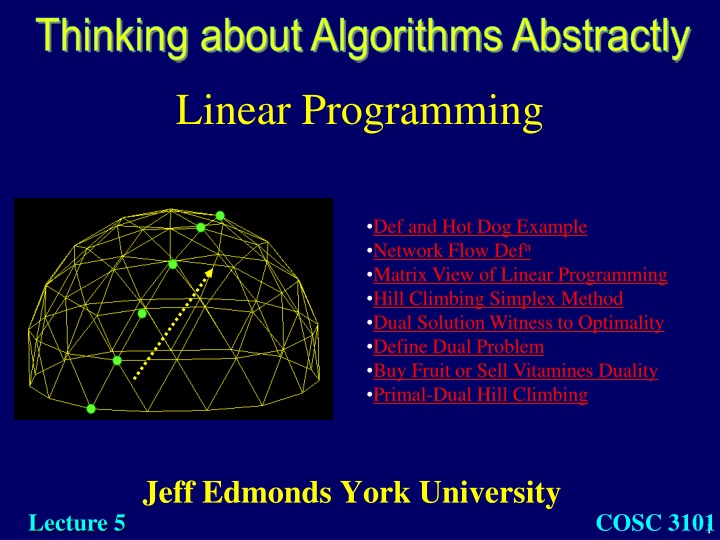
Linear Programming and Hotdogs: Optimizing Costs and Constraints
The concepts of linear programming applied in industrial fields such as manufacturing and logistics. Understand the optimization of costs and constraints using examples like the hotdog problem.
Download Presentation

Please find below an Image/Link to download the presentation.
The content on the website is provided AS IS for your information and personal use only. It may not be sold, licensed, or shared on other websites without obtaining consent from the author. If you encounter any issues during the download, it is possible that the publisher has removed the file from their server.
You are allowed to download the files provided on this website for personal or commercial use, subject to the condition that they are used lawfully. All files are the property of their respective owners.
The content on the website is provided AS IS for your information and personal use only. It may not be sold, licensed, or shared on other websites without obtaining consent from the author.
E N D
Presentation Transcript
Thinking about Algorithms Abstractly Linear Programming Def and Hot Dog Example Network Flow Defn Matrix View of Linear Programming Hill Climbing Simplex Method Dual Solution Witness to Optimality Define Dual Problem Buy Fruit or Sell Vitamines Duality Primal-Dual Hill Climbing Jeff Edmonds York University Lecture5 COSC 3101 1
Linear Programming Linear Program: An optimization problem whose constraints and cost function are linear functions Goal: Find a solution which optimizes the cost. Applied in various industrial fields: Manufacturing, Supply-Chain, Logistics, Marketing E.g. Maximize Cost Function : 21x1 - 6x2 100x3 - 100x4 To save money and increase profits ! Constraint Functions: 5x1 + 2x2 +31x3 - 20x4 21 1x1 - 4x2 +3x3 + 10x1 56 6x1 + 60x2 - 31x3 - 15x4 200 .. 2
A Hotdog A combination of pork, grain, and sawdust, 3
Constraints: Amount of moisture Amount of protein, 4
The Hotdog Problem Given today s prices, what is a fast algorithm to find the cheapest hotdog? 5
Abstract Out Essential Details Amount to add: x1, x2, x3, x4 Cost: 29, 8, 1, 2 Cost of Hotdog: 29x1 + 8x2 + 1x3 + 2x4 3x1 + 4x2 7x3 + 8x4 12 2x1 - 8x2 + 4x3 - 3x4 24 -8x1 + 2x2 3x3 - 9x4 8 x1 + 2x2 + 9x3 - 3x4 31 Constraints: moisture protein, 6
Abstract Out Essential Details Minimize: 29x1 + 8x2 + 1x3 + 2x4 Subject to: 3x1 + 4x2 7x3 + 8x4 12 2x1 - 8x2 + 4x3 - 3x4 24 -8x1 + 2x2 3x3 - 9x4 8 x1 + 2x2 + 9x3 - 3x4 31 7
Network Flow as a Linear Program Given an instance of Network Flow: <G,c<u,v>> express it as a Linear Program: The variables: Maximize: Subject to: <u,v>:F<u,v> c<u,v>. (Flow can't exceed capacity) v: u F<u,v> = wF<v,w> (flow in = flow out) Flows f<u,v>for each edge. rate(F) = u F<u,t> - v F<t,v> 8
Do all Linear Programs have optimal solutions ? No ! Three types of Linear Programs: 1. Has an optimal solution with a finite cost value: e.g. hotdog problem 2. Unbounded: e.g maximize x, x x 3. Infeasible: e.g maximize x, x x x 9
Linear Programming Linear Program Minimize: CT X Subject to: M X N minimize subject to Cj Mi,j Ni Xj Xj Xj 0 n variable xj that we are looking for values of. An optimization function Each has a variable has a coefficient cj. The dot product CT X gives one value to minimize. m constraints: Some linear combination of the variables must be at least some set value. i Mi X Ni Generally implied that variables are positive.
Linear Programming Linear Program Minimize: CT X Subject to: M X N minimize subject to Cj Mi,j Ni = Xj Xj maximize subject to Cj Maximize: CT X Subject to: M X N Mi,j Ni = Xj Xj These are the linear programs in standard form Minimize CT X hence X subject to X Maximize CT X hence X subject to X But you could mix and match.
Simplex Algorithm Invented by George Dantzig in 1947 A hill climbing algorithm Global Max Local Max
Simplex Algorithm Invented by George Dantzig in 1947 A hill climbing algorithm Guaranteed to find an global optimal solution for Linear Programs Global Max
Simplex Algorithm Computes solution to a Linear Program by evaluating vertices where constraints intersect each other. The feasible region defined by the constraints is convex and is called a simplex . Worst case exponential time because with n equations and m constraints there are ? ? ? Practically very fast. Ellisoid algorithm (1979) First poly time O(n4L) algorithm. ?vertexes. ??
Simplex Algorithm With n variables, x1, x2, , xn, there are n dimensions. (Here n=2) Each constraint is an n-1 dimensional plain. (Here the 1-dim line) Each point in this space, is a solution. x2 It is a valid solution if it is on the correct side of each constraint plain Minimize Cost = 5x1 + 7x2 Constraint Functions C1: 2x1 + 4x2 100 C2: 3x1 + 3x2 90 x1, x2 0 C1 C2 (0,0) x1
Simplex Algorithm Solutions on this line have one value of the objective function This has another These are not valid This is the optimal value x2 Cost Function Cost = 5x1 + 7x2 Constraint Functions C1: 2x1 + 4x2 100 C2: 3x1 + 3x2 90 x1, x2 0 C1 C2 (0,0) x1
Simplex Algorithm The arrow tells the direction that the optimal function increases. Note that the solution is a vertex. Each vertex is the intersection of n constraints. (Here n = #of variables = 2) This is why there are ? ?vertexes. ?? ? ? x2 Cost Function Cost = 5x1 + 7x2 Constraint Functions C1: 2x1 + 4x2 100 C2: 3x1 + 3x2 90 x1, x2 0 C1 C2 (0,0) x1
vertex Algorithm The arrow tells the direction that the optimal function increases. Note that the solution is a vertex. Each vertex is the intersection of n constraints. (Here n = #of variables = 2) The simplex method takes hill climbing steps, from one vertex (valid solution) to another.
Simplex Algorithm With n variables, x1, x2, x3 , xn, there are n dimensions. (Here n=3) Each constraint is an n-1 dimensional plain. (Here the 2-dim triangles) Each vertex is the intersection of n such constraints. (Here looks like 6 but generally only n=3) A vertex is specified by a subset of n of the m tight (=) constraints. Maximize Cost : 21x1 - 6x2 100x3 Constraint Functions: 5x1 + 2x2 +31x3 21 1x1 - 4x2 +3x3 56 6x1 + 60x2 - 31x3 200 -5x1 + 3x2 +4x3 8 x1, x2, x3 0 = = = All other constraints must be satisfied.
Simplex Algorithm If we slacken one of our n tight constrains, our solution slides along a 1-dim edge. Head in the direction that increases the potential function. A vertex is specified by a subset of n of the m tight (=) constraints. Maximize Cost : 21x1 - 6x2 100x3 Constraint Functions: 5x1 + 2x2 +31x3 21 1x1 - 4x2 +3x3 56 6x1 + 60x2 - 31x3 200 -5x1 + 3x2 +4x3 8 x1, x2, x3 0 = = =
Simplex Algorithm If we slacken one of our n tight constrains, our solution slides along a 1-dim edge. Head in the direction that increases the potential function. Keep sliding until we tighten some constraint. This is one hill climbing step. A vertex is specified by a subset of n of the m tight (=) constraints. Maximize Cost : 21x1 - 6x2 100x3 Constraint Functions: 5x1 + 2x2 +31x3 21 1x1 - 4x2 +3x3 56 6x1 + 60x2 - 31x3 200 -5x1 + 3x2 +4x3 8 x1, x2, x3 0 = = =
Simplex Algorithm If we slacken one of our n tight constrains, our solution slides along a 1-dim edge. Head in the direction that increases the potential function. Keep sliding until we tighten some constraint. This is one hill climbing step. A vertex is specified by a subset of n of the m tight (=) constraints. Maximize Cost : 21x1 - 6x2 100x3 Constraint Functions: 5x1 + 2x2 +31x3 21 1x1 - 4x2 +3x3 56 6x1 + 60x2 - 31x3 200 -5x1 + 3x2 +4x3 8 x1, x2, x3 0
Simplex Algorithm But practically it tends to be fast. Bread and butter of optimization in industry. A vertex is specified by a subset of n of the m tight (=) constraints. Maximize Cost : 21x1 - 6x2 100x3 Constraint Functions: 5x1 + 2x2 +31x3 21 1x1 - 4x2 +3x3 56 6x1 + 60x2 - 31x3 200 -5x1 + 3x2 +4x3 8 x1, x2, x3 0
Dual Primal 24
Hill Climbing We have a valid solution. (not necessarily optimal) Value of our solution. measure progress Take a step that goes up. Make small local changes to your solution to construct a slightly better solution. Initially have the zero Global Max Exit Can't take a step that goes up. Local Max Problems: Running time? If you take small step, could be exponential time. Can our Simplex Algorithm get stuck in a local maximum? 25
Hill Climbing Avoiding getting stuck in a local maximum Bad Execution Good Execution Made better choices of direction Hard Back up an retry Exponential time Define a bigger step 26
Network Flow Can our Simplex Algorithm get stuck in local max? Need to prove for every linear program for every choice of steps an optimal solution is found! No! How? 27
Primal-Dual Hill Climbing Mars settlement has hilly landscape and many layers of roofs. 28
Primal-Dual Hill Climbing Primal Problem: Exponential # of locations to stand. Find a highest one. Dual problem: Exponential # of roofs. Find a lowest one. 29
Primal-Dual Hill Climbing Prove: Every roof is above every location to stand. R L height(R) height(L) height(Rmin) height(Lmax) Is there a gap? 30
Primal-Dual Hill Climbing Prove: For every location to stand either: the alg takes a step up or the alg gives a reason that explains why not by giving a roof of equal height. i.e. L [ L height(L ) height(L) or R height(R) = height(L)] or No Gap But R L height(R) height(L) 31
Primal-Dual Hill Climbing Prove: For every location to stand either: the alg takes a step up or the alg gives a reason that explains why not by giving a roof of equal height. i.e. L [ L height(L ) height(L) or R height(R) = height(L)] or ? Can't go up from this location and no matching roof. Can't happen! 32
Primal-Dual Hill Climbing Prove: For every location to stand either: the alg takes a step up or the alg gives a reason that explains why not by giving a roof of equal height. i.e. L [ L height(L ) height(L) or R height(R) = height(L)] or No local maximum! 33
Primal-Dual Hill Climbing Exit Claim: Primal and dual have the same optimal value. height(Rmin) = height(Lmax) Proved: R L, height(R) height(L) Proved: Alg runs until it provides Lalg and Ralg height(Ralg) = height(Lalg) height(Rmin) height(Ralg) =height(Lalg) height(Lmax) height(Rmin) height(Lmax) No Gap Lalg witness that height(Lmax) is no smaller. Ralg witness that height(Lmax) is no bigger. 34
Primal-Dual Hill Climbing The Primal problem (where to stand) is a linear program. What is the Dual problem (roofs)? Ralg witness that height(Lmax) is no bigger. 35
Duality Linear Program Minimize: CT X Subject to: M X N minimize subject to Cj Mi,j Ni Xj Xj Xj 0 n variable xj that we are looking for values of. An optimization function Each has a variable has a coefficient cj. The dot product CT X gives one value to minimize. m constraints: Some linear combination of the variables must be at least some set value. i Mi X Ni Generally implied that variables are positive.
For every primal linear program, we define its dual linear program. Primal Linear Program Minimize: CT X Subject to: M X N Duality Key parameters Cj Mi,j Ni Yi Xj Dual Linear Program Ni MTj,i Cj Xj Everything is turned upside down. Yi
For every primal linear program, we define its dual linear program. Primal Linear Program Minimize: CT X Subject to: M X N Duality minimize subject to Cj Mi,j Ni Xj Xj Xj 0 Dual Linear Program subject to ? Ni Yi Yi MTj,i Everything is turned upside down. The matrix of coefficients is transposed For each constraint, a variable. Form the objective function vector from the constraint vector. Yi 0
For every primal linear program, we define its dual linear program. Primal Linear Program Minimize: CT X Subject to: M X N Duality minimize subject to Cj Mi,j Ni Xj Xj Xj 0 Dual Linear Program subject to Ni Yi Yi MTj,i ? Cj Everything is turned upside down. The matrix of coefficients is transposed For each constraint, a variable. For each variable, a constraint. Form constraint vector from the objective function vector. Yi 0
For every primal linear program, we define its dual linear program. Primal Linear Program Minimize: CT X Subject to: M X N Duality minimize subject to Cj Mi,j Ni Xj Xj Xj 0 Dual Linear Program Maximize NT Y Subject to: MT Y C maximize subject to Ni Yi Yi MTj,i Cj Everything is turned upside down. The matrix of coefficients is transposed For each constraint, a variable. For each variable, a constraint. Max Min and Yi 0
For every primal linear program, we define its dual linear program. Primal Linear Program Minimize: CT X Subject to: M X N Duality minimize subject to Cj = Ni Mi,j Ni Xj Xj Xj 0 Dual Linear Program Maximize NT Y Subject to: MT Y C maximize subject to Ni Yi Yi MTj,i Cj Everything is turned upside down. The matrix of coefficients is transposed For each constraint, a variable. For each variable, a constraint. Max Min and If a constraint is = , then the variable Yi is unconstrained. Yi 0 Yi 0
For every primal linear program, we define its dual linear program. Primal Linear Program Minimize: CT X Subject to: M X N Duality minimize subject to Cj Mi,j Ni Xj Xj subject to Xj 0 Xj 0 Dual Linear Program Maximize NT Y Subject to: MT Y C maximize Ni Yi Yi = Cj MTj,i Cj Everything is turned upside down. The matrix of coefficients is transposed For each constraint, a variable. For each variable, a constraint. Max Min and If a variable Xj is unconstrained, then the constraint is = . Yi 0
For every primal linear program, we define its dual linear program. Primal Linear Program Minimize: CT X Subject to: M X N Duality minimize subject to Cj Mi,j Ni Xj Xj Xj 0 Dual Linear Program Maximize NT Y Subject to: MT Y C maximize subject to Ni Yi Yi MTj,i Cj Everything is turned upside down. The matrix of coefficients is transposed For each constraint, a variable. For each variable, a constraint. Max Min and Dual of the dual is ? Yi 0 itself!
For every primal linear program, we define its dual linear program. Primal Linear Program Minimize: CT X Subject to: M X N Duality minimize subject to Cj Mi,j Ni Xj Xj Xj 0 Dual Linear Program Maximize NT Y Subject to: MT Y C maximize subject to Ni Yi Yi MTj,i Cj Everything is turned upside down. Max Location Max Flow We saw this linear program. Simple to understand. Yi 0 Min Roof Min Cut Oops. Quite complicated
For every primal linear program, we define its dual linear program. Primal Linear Program Minimize: CT X Subject to: M X N Duality minimize subject to Cj Mi,j Ni Xj Xj Xj 0 Dual Linear Program Maximize NT Y Subject to: MT Y C maximize subject to Ni Yi Yi MTj,i Cj Everything is turned upside down. Max Location Max Flow Buyer of nutrients in fruit Yi 0 Min Roof Min Cut Seller of nutrients in vitamins
Primal-Dual Hill Climbing Prove: Every roof is above every location to stand. R L height(R) height(L) height(Rmin) height(Lmax) Is there a gap? 46
For every primal linear program, we define its dual linear program. Primal Linear Program Minimize: CT X Subject to: M X N Duality minimize subject to Cj Mi,j Ni Xj Xj Dual Linear Program Maximize NT Y Subject to: MT Y C maximize subject to Ni Yi Yi MTj,i Cj Every solution X of the primal is above every solution Y of the primal. X Y CT X = XT C Xj Cj = = Cj Xj NT Y
For every primal linear program, we define its dual linear program. Primal Linear Program Minimize: CT X Subject to: M X N Duality minimize subject to Cj Mi,j Ni Xj Xj Dual Linear Program Maximize NT Y Subject to: MT Y C maximize subject to Ni Yi Yi MTj,i Cj Every solution X of the primal is above every solution Y of the primal. X Y CT X = XT C XT MT Y ( )T = T T Xj Ni MTj,i NT Y
For every primal linear program, we define its dual linear program. Primal Linear Program Minimize: CT X Subject to: M X N Duality minimize subject to Cj Mi,j Ni Xj Xj Dual Linear Program Maximize NT Y Subject to: MT Y C maximize subject to Ni Yi Yi MTj,i Cj Every solution X of the primal is above every solution Y of the primal. X Y CT X NT Y CT Xmin NT Ymax We will prove equality using the algorithm.
The Nutrition Problem An apple a day keeps the doctor away but apples are costly! A customer s goal is to fulfill daily vitamin requirements at lowest cost.

